Introduction
Materials and Methods
1. Data sources
2. Cancer classification
3. Statistical analyses
Results
1. Incidence
Table 1.
| Site/Type |
New cases |
Deaths |
Prevalent casesa) |
||||||
|---|---|---|---|---|---|---|---|---|---|
| Both sexes | Men | Women | Both sexes | Men | Women | Both sexes | Men | Women | |
| All sites | 232,255 | 122,292 | 109,963 | 78,863 | 48,866 | 29,997 | 1,867,405 | 819,838 | 1,047,567 |
| Lip, oral cavity, and pharynx | 3,667 | 2,625 | 1,042 | 1,199 | 928 | 271 | 25,450 | 17,007 | 8,443 |
| Esophagus | 2,483 | 2,239 | 244 | 1,423 | 1,290 | 133 | 10,403 | 9,319 | 1,084 |
| Stomach | 29,685 | 19,916 | 9,769 | 8,034 | 5,166 | 2,868 | 289,223 | 191,389 | 97,834 |
| Colon and rectum | 28,111 | 16,653 | 11,458 | 8,691 | 4,981 | 3,710 | 251,063 | 149,310 | 101,753 |
| Liverb) | 15,405 | 11,500 | 3,905 | 10,721 | 7,982 | 2,739 | 68,077 | 51,068 | 17,009 |
| Gallbladderc) | 6,846 | 3,555 | 3,291 | 4,717 | 2,392 | 2,325 | 22,375 | 11,479 | 10,896 |
| Pancreas | 7,032 | 3,733 | 3,299 | 5,782 | 2,976 | 2,806 | 11,776 | 6,172 | 5,604 |
| Larynx | 1,218 | 1,142 | 76 | 372 | 349 | 23 | 10,990 | 10,334 | 656 |
| Lungd) | 26,985 | 18,657 | 8,328 | 17,980 | 13,272 | 4,708 | 84,242 | 51,808 | 32,434 |
| Breast | 22,395 | 95 | 22,300 | 2,517 | 20 | 2,497 | 217,203 | 801 | 216,402 |
| Cervix uteri | 3,469 | - | 3,469 | 868 | - | 868 | 54,914 | - | 54,914 |
| Corpus uteri | 2,986 | - | 2,986 | 320 | - | 320 | 25,590 | - | 25,590 |
| Ovary | 2,702 | - | 2,702 | 1,149 | - | 1,149 | 21,013 | - | 21,013 |
| Prostate | 12,797 | 12,797 | - | 1,821 | 1,821 | - | 86,435 | 86,435 | - |
| Testis | 262 | 262 | - | 15 | 15 | - | 3,441 | 3,441 | - |
| Kidney | 5,299 | 3,617 | 1,682 | 1,000 | 687 | 313 | 42,513 | 28,611 | 13,902 |
| Bladder | 4,379 | 3,525 | 854 | 1,438 | 1,100 | 338 | 35,585 | 29,024 | 6,561 |
| Brain and CNS | 1,947 | 1,036 | 911 | 1,319 | 738 | 581 | 11,719 | 5,998 | 5,721 |
| Thyroid | 26,170 | 6,035 | 20,135 | 369 | 111 | 258 | 405,032 | 71,015 | 334,017 |
| Hodgkin lymphoma | 287 | 172 | 115 | 55 | 43 | 12 | 3,004 | 1,871 | 1,133 |
| Non-Hodgkin lymphoma | 4,762 | 2,708 | 2,054 | 1,786 | 997 | 789 | 32,519 | 18,475 | 14,044 |
| Multiple myeloma | 1,629 | 857 | 772 | 964 | 512 | 452 | 6,375 | 3,339 | 3,036 |
| Leukemia | 3,366 | 1,916 | 1,450 | 1,834 | 1,042 | 792 | 22,218 | 12,369 | 9,849 |
| Other and ill-defined | 18,373 | 9,252 | 9,121 | 4,489 | 2,444 | 2,045 | 126,245 | 60,573 | 65,672 |
Table 2.
| Site/Type |
Crude incidence rate per 100,000 |
Age-standardized incidence rate per 100,000a) |
||||
|---|---|---|---|---|---|---|
| Both sexes | Men | Women | Both sexes | Men | Women | |
| All sites | 453.4 | 478.1 | 428.6 | 264.4 | 291.3 | 251.5 |
| Lip, oral cavity, and pharynx | 7.2 | 10.3 | 4.1 | 4.3 | 6.3 | 2.4 |
| Esophagus | 4.8 | 8.8 | 1.0 | 2.6 | 5.1 | 0.5 |
| Stomach | 57.9 | 77.9 | 38.1 | 32.0 | 46.4 | 19.6 |
| Colon and rectum | 54.9 | 65.1 | 44.7 | 29.7 | 38.8 | 21.8 |
| Liverb) | 30.1 | 45.0 | 15.2 | 16.5 | 26.8 | 7.2 |
| Gallbladderc) | 13.4 | 13.9 | 12.8 | 6.6 | 8.0 | 5.5 |
| Pancreas | 13.7 | 14.6 | 12.9 | 7.1 | 8.5 | 5.8 |
| Larynx | 2.4 | 4.5 | 0.3 | 1.3 | 2.6 | 0.1 |
| Lungd) | 52.7 | 72.9 | 32.5 | 27.1 | 42.1 | 15.5 |
| Breast | 43.7 | 0.4 | 86.9 | 28.0 | 0.2 | 55.6 |
| Cervix uteri | 6.8 | - | 13.5 | 4.4 | - | 8.7 |
| Corpus uteri | 5.8 | - | 11.6 | 3.7 | - | 7.3 |
| Ovary | 5.3 | - | 10.5 | 3.4 | - | 6.8 |
| Prostate | 25.0 | 50.0 | - | 12.9 | 28.9 | - |
| Testis | 0.5 | 1.0 | - | 0.5 | 1.0 | - |
| Kidney | 10.3 | 14.1 | 6.6 | 6.3 | 8.9 | 3.8 |
| Bladder | 8.5 | 13.8 | 3.3 | 4.3 | 8.0 | 1.5 |
| Brain and CNS | 3.8 | 4.1 | 3.6 | 2.9 | 3.1 | 2.7 |
| Thyroid | 51.1 | 23.6 | 78.5 | 36.8 | 17.0 | 57.2 |
| Hodgkin lymphoma | 0.6 | 0.7 | 0.4 | 0.5 | 0.6 | 0.4 |
| Non-Hodgkin lymphoma | 9.3 | 10.6 | 8.0 | 6.0 | 7.4 | 4.8 |
| Multiple myeloma | 3.2 | 3.4 | 3.0 | 1.7 | 2.0 | 1.5 |
| Leukemia | 6.6 | 7.5 | 5.7 | 5.2 | 6.2 | 4.3 |
| Other and ill-defined | 35.9 | 36.2 | 35.6 | 20.6 | 23.2 | 18.5 |
2. Mortality
Table 3.
| Rank | Cause of death | No. of deaths | Percentage of all deaths | Age-standardized mortality rate per 100,000a) |
|---|---|---|---|---|
| All causes | 285,534 | 100.0 | 270.1 | |
| 1 | Cancer | 78,863 | 27.6 | 76.6 |
| 2 | Heart disease | 30,852 | 10.8 | 27.2 |
| 3 | Cerebrovascular disease | 22,745 | 8.0 | 19.7 |
| 4 | Pneumonia | 19,378 | 6.8 | 15.6 |
| 5 | Intentional self-harm (suicide) | 12,463 | 4.4 | 16.7 |
| 6 | Diabetes mellitus | 9,184 | 3.2 | 8.0 |
| 7 | Disease of liver | 6,797 | 2.4 | 7.5 |
| 8 | Chronic lower respiratory diseases | 6,750 | 2.4 | 5.4 |
| 9 | Hypertensive diseases | 5,775 | 2.0 | 4.6 |
| 10 | Transport accidents | 5,028 | 1.8 | 6.4 |
| Others | 87,699 | 30.7 | 82.5 |
Source: Mortality Data, 2017, Statistics Korea [6].
Table 4.
| Site/Type |
Crude incidence rate per 100,000 |
Age-standardized incidence rate per 100,000a) |
||||
|---|---|---|---|---|---|---|
| Both sexes | Men | Women | Both sexes | Men | Women | |
| All sites | 153.9 | 191.1 | 116.9 | 76.6 | 111.0 | 51.2 |
| Lip, oral cavity, and pharynx | 2.3 | 3.6 | 1.1 | 1.2 | 2.1 | 0.5 |
| Esophagus | 2.8 | 5.0 | 0.5 | 1.4 | 2.9 | 0.2 |
| Stomach | 15.7 | 20.2 | 11.2 | 7.7 | 11.8 | 4.6 |
| Colon and rectum | 17.0 | 19.5 | 14.5 | 8.1 | 11.3 | 5.6 |
| Liverb) | 20.9 | 31.2 | 10.7 | 10.9 | 18.3 | 4.5 |
| Gallbladderc) | 9.2 | 9.4 | 9.1 | 4.3 | 5.3 | 3.5 |
| Pancreas | 11.3 | 11.6 | 10.9 | 5.6 | 6.7 | 4.6 |
| Larynx | 0.7 | 1.4 | 0.1 | 0.3 | 0.8 | 0.0 |
| Lungd) | 35.1 | 51.9 | 18.4 | 16.7 | 29.4 | 7.4 |
| Breast | 4.9 | 0.1 | 9.7 | 2.9 | 0.0 | 5.5 |
| Cervix uteri | 1.7 | - | 3.4 | 0.9 | - | 1.7 |
| Corpus uteri | 0.6 | - | 1.2 | 0.3 | - | 0.7 |
| Ovary | 2.2 | - | 4.5 | 1.2 | - | 2.4 |
| Prostate | 3.6 | 7.1 | - | 1.5 | 4.0 | - |
| Testis | 0.0 | 0.1 | - | 0.0 | 0.0 | - |
| Kidney | 2.0 | 2.7 | 1.2 | 1.0 | 1.6 | 0.5 |
| Bladder | 2.8 | 4.3 | 1.3 | 1.2 | 2.5 | 0.5 |
| Brain and CNS | 2.6 | 2.9 | 2.3 | 1.7 | 2.0 | 1.4 |
| Thyroid | 0.7 | 0.4 | 1.0 | 0.3 | 0.2 | 0.4 |
| Hodgkin lymphoma | 0.1 | 0.2 | 0.0 | 0.1 | 0.1 | 0.0 |
| Non-Hodgkin lymphoma | 3.5 | 3.9 | 3.1 | 1.8 | 2.3 | 1.4 |
| Multiple myeloma | 1.9 | 2.0 | 1.8 | 0.9 | 1.1 | 0.8 |
| Leukemia | 3.6 | 4.1 | 3.1 | 2.1 | 2.7 | 1.7 |
| Other and ill-defined | 8.8 | 9.6 | 8.0 | 4.5 | 5.8 | 3.5 |
3. Trends in cancer incidence and mortality
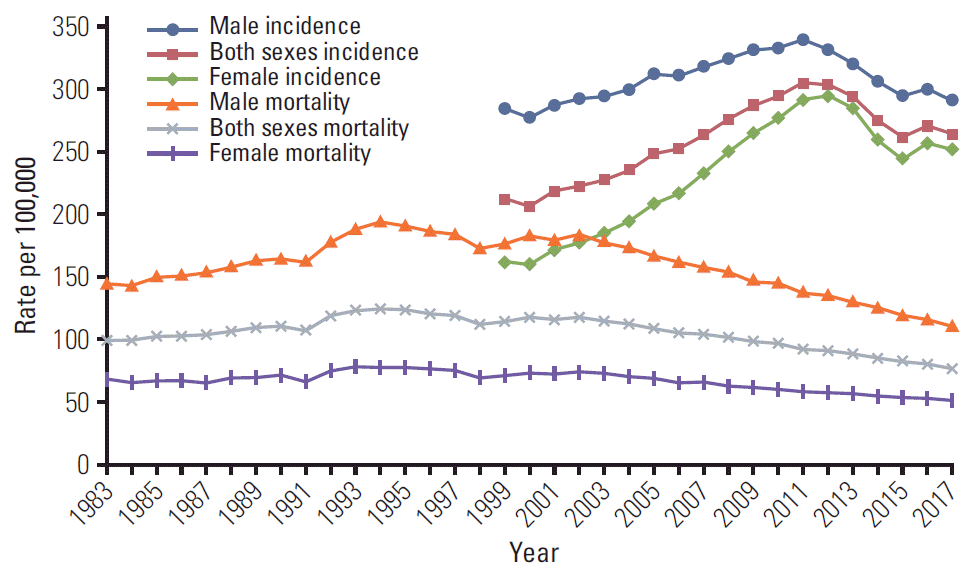 | Fig. 3.Annual age-standardized cancer incidence and mortality rates by sex for all sites from 1983 to 2017 in Korea. Age standardization was based on Segi’s world standard population. |
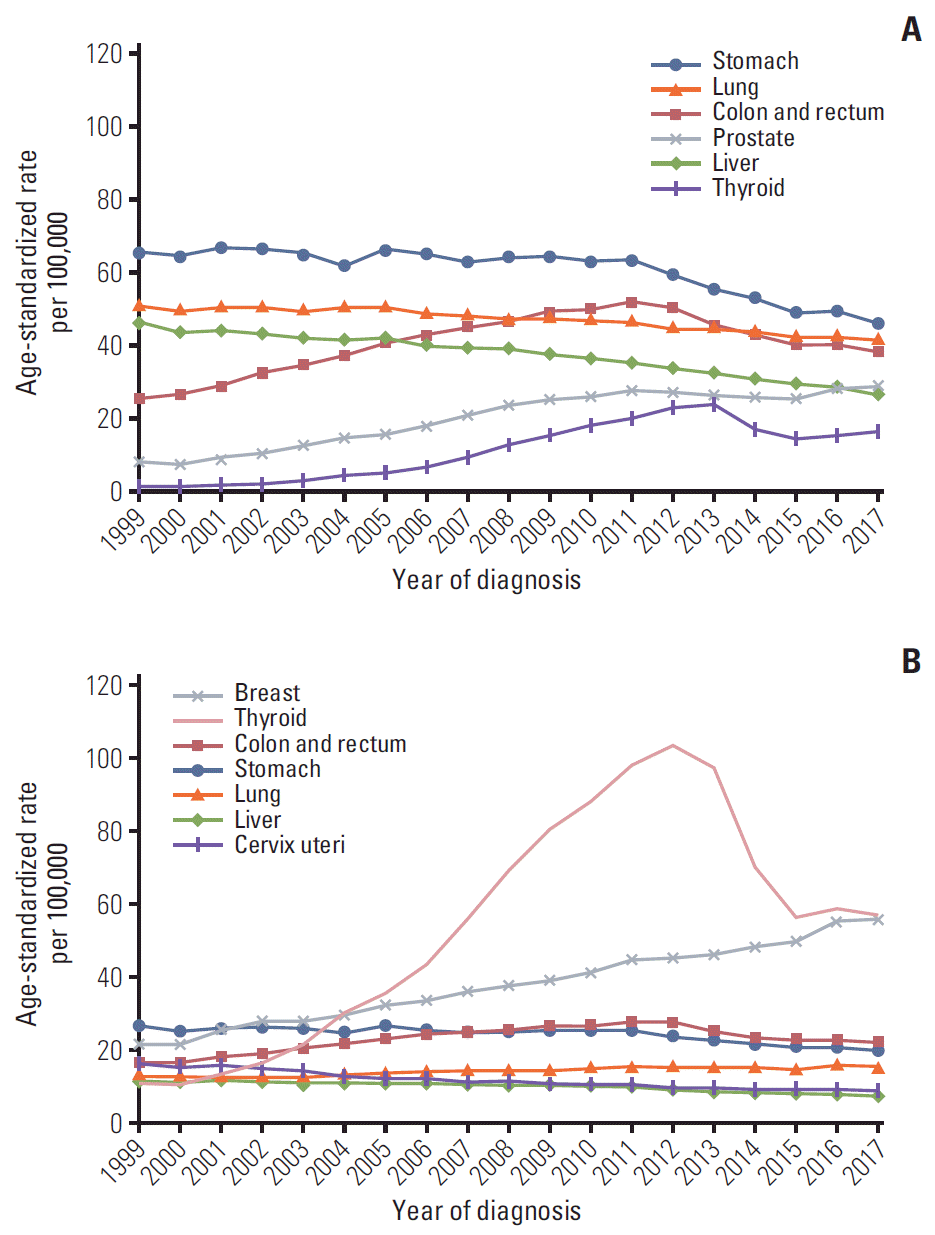 | Fig. 4.Trends in age-standardized incidences of selected cancers by sex from 1999 to 2017 in Korea. (A) Men. (B) Women. Age standardization was based on Segi’s world standard population. |
Table 5.
| Site/Type |
Both sexes |
Men |
Women |
|||||||||||||||
|---|---|---|---|---|---|---|---|---|---|---|---|---|---|---|---|---|---|---|
| 1999 | 2017 |
Trend 1 |
Trend 2 |
1999 | 2017 |
Trend 1 |
Trend 2 |
1999 | 2017 |
Trend 1 |
Trend 2 |
|||||||
| Year | APC | Year | APC | Year | APC | Year | APC | Year | APC | Year | APC | |||||||
| All sites | 211.6 | 264.4 | 1999-2011 | 3.5a) | 2011-2017 | –2.7a) | 285.4 | 291.3 | 1999-2011 | 1.6a) | 2011-2017 | –2.7a) | 162.7 | 251.5 | 1999-2011 | 5.6a) | 2011-2017 | –2.9a) |
| Lip, oral cavity, and pharynx | 3.6 | 4.3 | 1999-2017 | 0.6a) | - | - | 6.1 | 6.3 | 1999-2017 | –0.1 | - | - | 1.6 | 2.4 | 1999-2017 | 1.5a) | - | - |
| Esophagus | 4.0 | 2.6 | 1999-2017 | –2.3a) | - | - | 8.8 | 5.1 | 1999-2017 | –2.8a) | - | - | 0.6 | 0.5 | 1999-2017 | –1.3a) | - | - |
| Stomach | 43.6 | 32.0 | 1999-2011 | –0.2 | 2011-2017 | –4.7a) | 66.1 | 46.4 | 1999-2011 | –0.4a) | 2011-2017 | –5.2a) | 26.7 | 19.6 | 1999-2011 | –0.4 | 2011-2017 | –4.2a) |
| Colon and rectum | 20.5 | 29.7 | 1999-2010 | 5.9a) | 2010-2017 | –4.2a) | 26.2 | 38.8 | 1999-2010 | 6.4a) | 2010-2017 | –4.7a) | 16.5 | 21.8 | 1999-2010 | 4.7a) | 2010-2017 | –3.7a) |
| Liverb) | 27.8 | 16.5 | 1999-2010 | –1.7a) | 2010-2017 | –4.5a) | 46.6 | 26.8 | 1999-2009 | –1.8a) | 2009-2017 | –4.2a) | 12.2 | 7.2 | 1999-2010 | –1.4a) | 2010-2017 | –4.9a) |
| Gallbladderc) | 6.5 | 6.6 | 1999-2004 | 1.4 | 2004-2017 | –0.3 | 8.1 | 8.0 | 1999-2017 | 0.0 | - | - | 5.4 | 5.5 | 1999-2002 | 3.3 | 2002-2017 | –0.5a) |
| Pancreas | 5.6 | 7.1 | 1999-2017 | 1.4a) | - | - | 7.8 | 8.5 | 1999-2017 | 0.6a) | - | - | 4.0 | 5.8 | 1999-2017 | 2.3a) | - | - |
| Larynx | 2.4 | 1.3 | 1999-2017 | –3.6a) | - | - | 5.0 | 2.6 | 1999-2017 | –3.8a) | - | - | 0.4 | 0.1 | 1999-2007 | –9.2a) | 2007-2017 | –3.5a) |
| Lungd) | 28.4 | 27.1 | 1999-2010 | 0.2 | 2010-2017 | –0.9a) | 51.3 | 42.1 | 1999-2005 | 0.0 | 2005-2017 | –1.5a) | 12.5 | 15.5 | 1999-2011 | 1.9a) | 2011-2017 | 0.2 |
| Breast | 11.0 | 28.0 | 1999-2002 | 10.2a) | 2002-2017 | 4.7a) | 0.2 | 0.2 | 1999-2017 | –0.5 | - | - | 21.4 | 55.6 | 1999-2007 | 6.6a) | 2007-2017 | 4.4a) |
| Cervix uteri | 8.6 | 4.4 | 1999-2007 | –4.7a) | 2007-2017 | –3.1a) | - | - | - | - | - | - | 16.4 | 8.7 | 1999-2007 | –4.6a) | 2007-2017 | –2.8a) |
| Corpus uteri | 1.4 | 3.7 | 1999-2017 | 5.1a) | - | - | - | - | - | - | - | - | 2.8 | 7.3 | 1999-2017 | 5.3a) | - | - |
| Ovary | 2.7 | 3.4 | 1999-2017 | 1.6a) | - | - | - | - | - | - | - | - | 5.1 | 6.8 | 1999-2017 | 1.9a) | - | - |
| Prostate | 3.1 | 12.9 | 1999-2009 | 14.6a) | 2009-2017 | 1.5a) | 8.4 | 28.9 | 1999-2009 | 13.1a) | 2009-2017 | 0.8 | - | - | - | - | - | - |
| Testis | 0.3 | 0.5 | 1999-2015 | 4.9a) | 2015-2017 | –2.2 | 0.5 | 1.0 | 1999-2015 | 4.8a) | 2015-2017 | –2.4 | - | - | - | - | - | - |
| Kidney | 3.0 | 6.3 | 1999-2009 | 6.5a) | 2009-2017 | 1.9a) | 4.6 | 8.9 | 1999-2010 | 5.9a) | 2010-2017 | 1.1a) | 1.7 | 3.8 | 1999-2008 | 6.6a) | 2008-2017 | 2.4a) |
| Bladder | 4.6 | 4.3 | 1999-2004 | 2.0a) | 2004-2017 | –1.2a) | 9.0 | 8.0 | 1999-2004 | 1.9a) | 2004-2017 | –1.5a) | 1.6 | 1.5 | 1999-2017 | –1.0a) | - | - |
| Brain and CNS | 2.8 | 2.9 | 1999-2017 | 0.2 | - | - | 3.2 | 3.1 | 1999-2017 | 0.2 | - | - | 2.6 | 2.7 | 1999-2017 | 0.2 | - | - |
| Thyroid | 6.5 | 36.8 | 1999-2011 | 22.2a) | 2011-2017 | –11.2a) | 2.1 | 17.0 | 1999-2011 | 24.8a) | 2011-2017 | –6.7a) | 10.7 | 57.2 | 1999-2011 | 21.9a) | 2011-2017 | –12.2a) |
| Hodgkin lymphoma | 0.3 | 0.5 | 1999-2017 | 3.9a) | - | - | 0.4 | 0.6 | 1999-2017 | 3.0a) | - | - | 0.1 | 0.4 | 1999-2017 | 5.1a) | - | - |
| Non-Hodgkin lymphoma | 4.3 | 6.0 | 1999-2017 | 2.3a) | - | - | 5.6 | 7.4 | 1999-2017 | 1.9a) | - | - | 3.3 | 4.8 | 1999-2017 | 2.6a) | - | - |
| Multiple myeloma | 1.0 | 1.7 | 1999-2012 | 3.7a) | 2012-2017 | 1.0 | 1.2 | 2.0 | 1999-2012 | 3.5a) | 2012-2017 | 0.4 | 0.8 | 1.5 | 1999-2006 | 5.9a) | 2006-2017 | 2.3a) |
| Leukemia | 4.7 | 5.2 | 1999-2017 | 0.9a) | - | - | 5.5 | 6.2 | 1999-2017 | 1.0a) | - | - | 3.9 | 4.3 | 1999-2017 | 0.7a) | - | - |
| Other and ill-defined | 14.9 | 20.6 | 1999-2010 | 2.8a) | 2010-2017 | 1.4a) | 18.6 | 23.2 | 1999-2017 | 1.7a) | - | - | 12.3 | 18.5 | 1999-2010 | 3.4a) | 2010-2017 | 1.3a) |
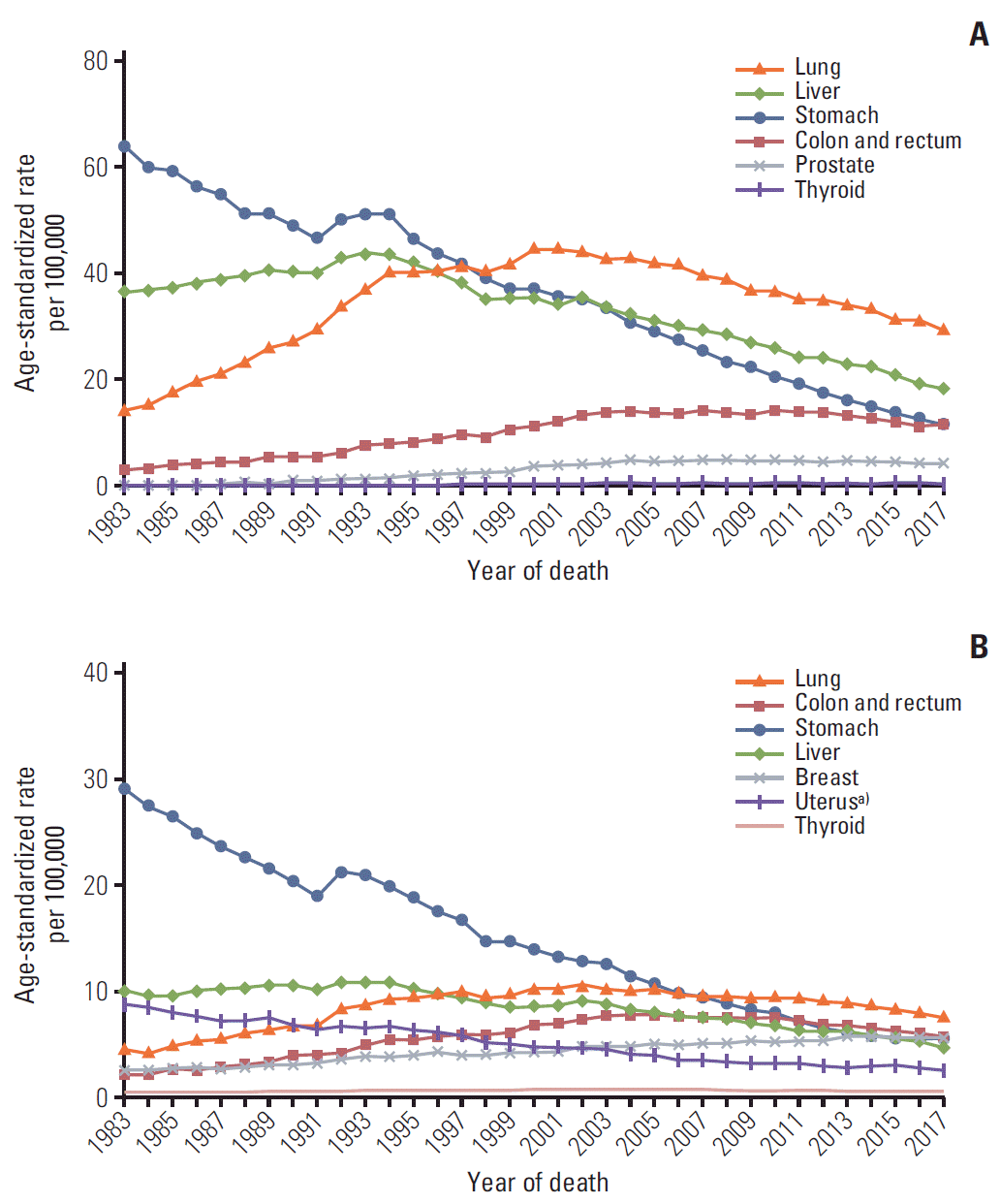 | Fig. 5.Trends in age-standardized mortalities of selected cancers by sex from 1983 to 2017 in Korea. (A) Men. (B) Women. Age standardization was based on Segi’s world standard population. a)Cancers of cervix uteri, corpus uteri, and unspecified parts of the uterus were combined (C53-C55), due to their unclear classifications in the past. |
Table 6.
| Site/Type |
Both sexes |
Men |
Women |
|||||||||||||||
|---|---|---|---|---|---|---|---|---|---|---|---|---|---|---|---|---|---|---|
| 1999 | 2017 |
Trend 1 |
Trend 2 |
1999 | 2017 |
Trend 1 |
Trend 2 |
1999 | 2017 |
Trend 1 |
Trend 2 |
|||||||
| Year | APC | Year | APC | Year | APC | Year | APC | Year | APC | Year | APC | |||||||
| All sites | 114.3 | 76.6 | 1999-2002 | 1.2 | 2002-2017 | –2.8a) | 176.6 | 111.0 | 1999-2002 | 1.4 | 2002-2017 | –3.2a) | 70.6 | 51.2 | 1999-2002 | 1.1 | 2002-2017 | –2.3a) |
| Lip, oral cavity, and pharynx | 1.1 | 1.2 | 1999-2017 | –1.7a) | - | - | 2.0 | 2.1 | 1999-2017 | –2.0a) | - | - | 0.4 | 0.5 | 1999-2017 | –2.5a) | - | - |
| Esophagus | 3.1 | 1.4 | 1999-2017 | –4.4a) | - | - | 6.8 | 2.9 | 1999-2017 | –4.7a) | - | - | 0.5 | 0.2 | 1999-2010 | –6.3a) | 2010-2017 | –1.3 |
| Stomach | 23.8 | 7.7 | 1999-2003 | –3.1a) | 2003-2017 | –6.8a) | 36.9 | 11.8 | 1999-2003 | –2.4a) | 2003-2017 | –7.1a) | 14.6 | 4.6 | 1999-2003 | –4.4a) | 2003-2017 | –6.6a) |
| Colon and rectum | 7.7 | 8.1 | 1999-2005 | 4.6a) | 2005-2017 | –1.9a) | 10.5 | 11.3 | 1999-2007 | 3.3a) | 2007-2017 | –2.3a) | 6.0 | 5.6 | 1999-2005 | 3.9a) | 2005-2017 | –2.4a) |
| Liverb) | 20.4 | 10.9 | 1999-2003 | –0.1 | 2003-2017 | –4.0a) | 35.3 | 18.3 | 1999-2008 | –2.6a) | 2008-2017 | –4.6a) | 8.3 | 4.5 | 1999-2002 | 3.4 | 2002-2017 | –4.0a) |
| Gallbladderc) | 5.2 | 4.3 | 1999-2001 | 6.3 | 2001-2017 | –2.4a) | 6.8 | 5.3 | 1999-2017 | –2.2a) | - | - | 4.1 | 3.5 | 1999-2001 | 8.4 | 2001-2017 | –2.4a) |
| Pancreas | 5.4 | 5.6 | 1999-2017 | 0.2a) | - | - | 7.6 | 6.7 | 1999-2015 | –0.3a) | 2015-2017 | –3.6 | 3.9 | 4.6 | 1999-2017 | 0.9a) | - | - |
| Larynx | 1.6 | 0.3 | 1999-2017 | –9.3a) | - | - | 3.4 | 0.8 | 1999-2017 | –8.9a) | - | - | 0.4 | 0.0 | 1999-2010 | –15.2a) | 2010-2017 | –8.5a) |
| Lungd) | 22.4 | 16.7 | 1999-2001 | 2.1 | 2001-2017 | –2.2a) | 41.5 | 29.4 | 1999-2002 | 2.0 | 2002-2017 | –2.6a) | 9.4 | 7.4 | 1999-2013 | –1.0a) | 2013-2017 | –4.5a) |
| Breast | 2.2 | 2.9 | 1999-2003 | 3.3a) | 2003-2017 | 1.1a) | 0.1 | 0.0 | 1999-2017 | –4.1a) | - | - | 4.2 | 5.5 | 1999-2004 | 3.1a) | 2004-2017 | 1.3a) |
| Cervix uteri | 1.4 | 0.9 | 1999-2003 | 8.3a) | 2003-2017 | –5.1a) | - | - | - | - | - | - | 2.6 | 1.7 | 1999-2003 | 7.7a) | 2003-2017 | –4.8a) |
| Corpus uteri | 0.1 | 0.3 | 1999-2002 | 52.8a) | 2002-2017 | 3.1a) | - | - | - | - | - | - | 0.1 | 0.7 | 1999-2003 | 35.3a) | 2003-2017 | 3.1a) |
| Ovary | 0.9 | 1.2 | 1999-2001 | 10.3 | 2001-2017 | 0.3 | - | - | - | - | - | - | 1.7 | 2.4 | 1999-2001 | 9.6 | 2001-2017 | 0.7a) |
| Prostate | 0.9 | 1.5 | 1999-2004 | 10.0a) | 2004-2017 | –0.1 | 2.6 | 4.0 | 1999-2004 | 10.0a) | 2004-2017 | –0.7 | - | - | - | - | - | - |
| Testis | 0.0 | 0.0 | 1999-2017 | –2.6a) | - | - | 0.1 | 0.0 | 1999-2017 | –3.0a) | - | - | - | - | - | - | - | - |
| Kidney | 1.1 | 1.0 | 1999-2017 | –0.2 | - | - | 1.8 | 1.6 | 1999-2017 | –0.2 | - | - | 0.5 | 0.5 | 1999-2017 | –0.6 | - | - |
| Bladder | 1.3 | 1.2 | 1999-2001 | 9.9 | 2001-2017 | –1.7a) | 2.6 | 2.5 | 1999-2017 | –1.6a) | - | - | 0.5 | 0.5 | 1999-2001 | 10.5 | 2001-2017 | –1.8a) |
| Brain and CNS | 1.9 | 1.7 | 1999-2002 | 4.1 | 2002-2017 | –1.9a) | 2.2 | 2.0 | 1999-2017 | –1.5a) | - | - | 1.6 | 1.4 | 1999-2017 | –1.4a) | - | - |
| Thyroid | 0.4 | 0.3 | 1999-2003 | 7.5a) | 2003-2017 | –4.5a) | 0.3 | 0.2 | 1999-2003 | 10.2 | 2003-2017 | –4.5a) | 0.5 | 0.4 | 1999-2004 | 4.5 | 2004-2017 | –4.9a) |
| Hodgkin lymphoma | 0.0 | 0.1 | 1999-2004 | 22.8a) | 2004-2017 | –1.6 | 0.0 | 0.1 | 1999-2004 | 18.8a) | 2004-2017 | –1.8 | 0.0 | 0.0 | 1999-2014 | 5.7a) | 2014-2017 | –32.2 |
| Non-Hodgkin lymphoma | 2.1 | 1.8 | 1999-2017 | –1.0a) | - | - | 3.0 | 2.3 | 1999-2017 | –1.3a) | - | - | 1.4 | 1.4 | 1999-2017 | –0.5 | - | - |
| Multiple myeloma | 0.6 | 0.9 | 1999-2003 | 13.1a) | 2003-2017 | 0.7 | 0.8 | 1.1 | 1999-2003 | 11.5a) | 2003-2017 | 0.5 | 0.4 | 0.8 | 1999-2005 | 10.0a) | 2005-2017 | 0.2 |
| Leukemia | 2.9 | 2.1 | 1999-2017 | –1.8a) | - | - | 3.5 | 2.7 | 1999-2017 | –1.7a) | - | - | 2.4 | 1.7 | 1999-2017 | –1.9a) | - | - |
| Other and ill-defined | 7.8 | 4.5 | 1999-2017 | –2.9a) | - | - | 9.0 | 5.8 | 1999-2017 | –2.7a) | - | - | 7.0 | 3.5 | 1999-2005 | –7.1a) | 2005-2017 | –2.0a) |
4. Survival rates
Table 7.
| Site/Type |
Both sexes |
Men |
Women |
||||||||||||||||||
|---|---|---|---|---|---|---|---|---|---|---|---|---|---|---|---|---|---|---|---|---|---|
| 1993-1995 | 1996-2000 | 2001-2005 | 2006-2010 | 2011-2015 | 2013-2017 | Changea) | 1993-1995 | 1996-2000 | 2001-2005 | 2006-2010 | 2011-2015 | 2013-2017 | Changea) | 1993-1995 | 1996-2000 | 2001-2005 | 2006-2010 | 2011-2015 | 2013-2017 | Changea) | |
| All sites | 42.9 | 45.1 | 54.1 | 65.5 | 70.7 | 70.4 | 27.5 | 33.2 | 36.3 | 45.6 | 56.8 | 63.1 | 63.5 | 30.3 | 55.1 | 56.4 | 64.3 | 74.4 | 78.4 | 77.5 | 22.4 |
| All sites excluding thyroid | 41.2 | 43.3 | 50.8 | 59.0 | 64.2 | 65.0 | 23.8 | 32.7 | 35.8 | 44.7 | 54.6 | 60.3 | 61.0 | 28.3 | 52.6 | 53.5 | 59.1 | 65.0 | 69.3 | 70.1 | 17.5 |
| Lip, oral cavity, and pharynx | 42.1 | 47.4 | 54.5 | 61.0 | 65.3 | 66.7 | 24.6 | 36.6 | 41.7 | 49.6 | 56.9 | 61.7 | 63.7 | 27.1 | 59.3 | 64.5 | 68.1 | 72.0 | 74.4 | 74.1 | 14.8 |
| Esophagus | 14.0 | 15.7 | 21.5 | 29.9 | 36.4 | 38.0 | 24.0 | 13.1 | 14.8 | 20.7 | 29.3 | 36.1 | 37.5 | 24.4 | 25.0 | 25.9 | 29.8 | 37.1 | 39.7 | 42.2 | 17.2 |
| Stomach | 43.9 | 47.3 | 58.0 | 68.4 | 75.9 | 76.5 | 32.6 | 43.9 | 47.6 | 58.7 | 69.1 | 76.8 | 77.5 | 33.6 | 43.7 | 46.8 | 56.6 | 67.0 | 74.0 | 74.6 | 30.9 |
| Colon and rectum | 56.2 | 58.8 | 66.9 | 73.9 | 76.2 | 75.0 | 18.8 | 56.6 | 59.8 | 68.8 | 75.8 | 77.9 | 76.6 | 20.0 | 55.7 | 57.7 | 64.4 | 71.1 | 73.7 | 72.6 | 16.9 |
| Liverb) | 11.7 | 14.1 | 20.5 | 28.2 | 34.3 | 35.6 | 23.9 | 10.8 | 13.8 | 20.4 | 28.2 | 34.8 | 36.4 | 25.6 | 15.0 | 15.1 | 20.9 | 28.3 | 32.7 | 33.2 | 18.2 |
| Gallbladderc) | 18.7 | 20.7 | 23.1 | 26.9 | 28.8 | 28.9 | 10.2 | 18.0 | 21.1 | 23.5 | 27.8 | 29.5 | 29.7 | 11.7 | 19.3 | 20.3 | 22.7 | 26.0 | 28.1 | 28.0 | 8.7 |
| Pancreas | 10.6 | 8.7 | 8.4 | 8.5 | 10.8 | 12.2 | 1.6 | 10.0 | 8.3 | 8.4 | 8.3 | 10.2 | 11.8 | 1.8 | 11.5 | 9.2 | 8.4 | 8.8 | 11.4 | 12.5 | 1.0 |
| Larynx | 61.6 | 63.3 | 66.5 | 73.2 | 75.0 | 77.0 | 15.4 | 62.1 | 63.7 | 67.1 | 73.5 | 75.4 | 77.4 | 15.3 | 56.3 | 58.9 | 58.6 | 68.0 | 69.2 | 69.6 | 13.3 |
| Lungd) | 12.5 | 13.6 | 16.5 | 20.2 | 27.5 | 30.2 | 17.7 | 11.6 | 12.4 | 15.3 | 18.0 | 23.2 | 25.2 | 13.6 | 15.8 | 17.5 | 20.1 | 26.0 | 37.2 | 41.5 | 25.7 |
| Breast | 79.2 | 83.6 | 88.6 | 91.2 | 92.7 | 93.2 | 14.0 | 77.1 | 84.3 | 87.5 | 89.9 | 89.4 | 94.7 | 17.6 | 79.2 | 83.6 | 88.7 | 91.2 | 92.7 | 93.2 | 14.0 |
| Cervix uteri | 78.3 | 80.3 | 81.5 | 80.7 | 80.2 | 80.2 | 1.9 | - | - | - | - | - | - | - | 78.3 | 80.3 | 81.5 | 80.7 | 80.2 | 80.2 | 1.9 |
| Corpus uteri | 82.9 | 82.0 | 84.8 | 86.5 | 87.8 | 88.2 | 5.3 | - | - | - | - | - | - | - | 82.9 | 82.0 | 84.8 | 86.5 | 87.8 | 88.2 | 5.3 |
| Ovary | 60.1 | 59.4 | 61.7 | 61.2 | 64.3 | 64.9 | 4.8 | - | - | - | - | - | - | - | 60.1 | 59.4 | 61.7 | 61.2 | 64.3 | 64.9 | 4.8 |
| Prostate | 59.1 | 69.2 | 81.0 | 91.9 | 94.1 | 94.1 | 35.0 | 59.1 | 69.2 | 81.0 | 91.9 | 94.1 | 94.1 | 35.0 | - | - | - | - | - | - | - |
| Testis | 87.4 | 90.4 | 90.7 | 93.1 | 95.1 | 95.2 | 7.8 | 87.4 | 90.4 | 90.7 | 93.1 | 95.1 | 95.2 | 7.8 | - | - | - | - | - | - | - |
| Kidney | 64.3 | 67.0 | 73.6 | 78.6 | 82.4 | 83.1 | 18.8 | 63.5 | 65.3 | 73.0 | 78.4 | 82.1 | 83.1 | 19.6 | 65.9 | 70.3 | 74.9 | 78.9 | 83.2 | 82.9 | 17.0 |
| Bladder | 70.7 | 73.6 | 76.0 | 77.2 | 76.4 | 76.8 | 6.1 | 71.6 | 75.1 | 77.8 | 79.2 | 78.3 | 78.8 | 7.2 | 67.1 | 67.3 | 69.1 | 69.1 | 68.6 | 68.9 | 1.8 |
| Brain and CNS | 40.4 | 39.9 | 41.0 | 42.9 | 41.3 | 40.8 | 0.4 | 39.1 | 38.7 | 40.3 | 41.3 | 39.7 | 39.2 | 0.1 | 42.1 | 41.4 | 41.8 | 44.6 | 43.0 | 42.5 | 0.4 |
| Thyroid | 94.5 | 95.0 | 98.4 | 100.0 | 100.2 | 100.1 | 5.6 | 87.9 | 89.6 | 96.0 | 100.2 | 100.6 | 100.4 | 12.5 | 95.7 | 96.0 | 98.7 | 99.9 | 100.1 | 100.0 | 4.3 |
| Hodgkin lymphoma | 70.1 | 71.9 | 76.7 | 81.0 | 82.2 | 83.7 | 13.6 | 69.2 | 69.3 | 74.7 | 80.8 | 81.7 | 81.3 | 12.1 | 71.5 | 77.3 | 80.7 | 81.5 | 83.1 | 87.8 | 16.3 |
| Non-Hodgkin lymphoma | 48.3 | 51.1 | 56.0 | 59.4 | 62.8 | 63.2 | 14.9 | 46.9 | 49.6 | 55.0 | 59.2 | 62.7 | 63.9 | 17.0 | 50.6 | 53.3 | 57.5 | 59.7 | 62.9 | 62.2 | 11.6 |
| Multiple myeloma | 23.5 | 21.0 | 29.7 | 35.0 | 41.2 | 43.3 | 19.8 | 23.0 | 19.1 | 29.8 | 35.2 | 40.8 | 43.6 | 20.6 | 24.1 | 23.3 | 29.5 | 34.7 | 41.7 | 43.1 | 19.0 |
| Leukemia | 27.5 | 34.3 | 42.0 | 47.7 | 51.9 | 53.0 | 25.5 | 27.3 | 33.3 | 41.8 | 46.9 | 52.2 | 53.6 | 26.3 | 27.8 | 35.5 | 42.2 | 48.7 | 51.5 | 52.3 | 24.5 |
| Other and ill-defined | 44.5 | 48.3 | 57.8 | 67.6 | 72.6 | 74.0 | 29.5 | 39.6 | 44.7 | 54.0 | 63.8 | 69.3 | 70.9 | 31.3 | 50.1 | 52.6 | 61.9 | 71.5 | 76.0 | 77.0 | 26.9 |
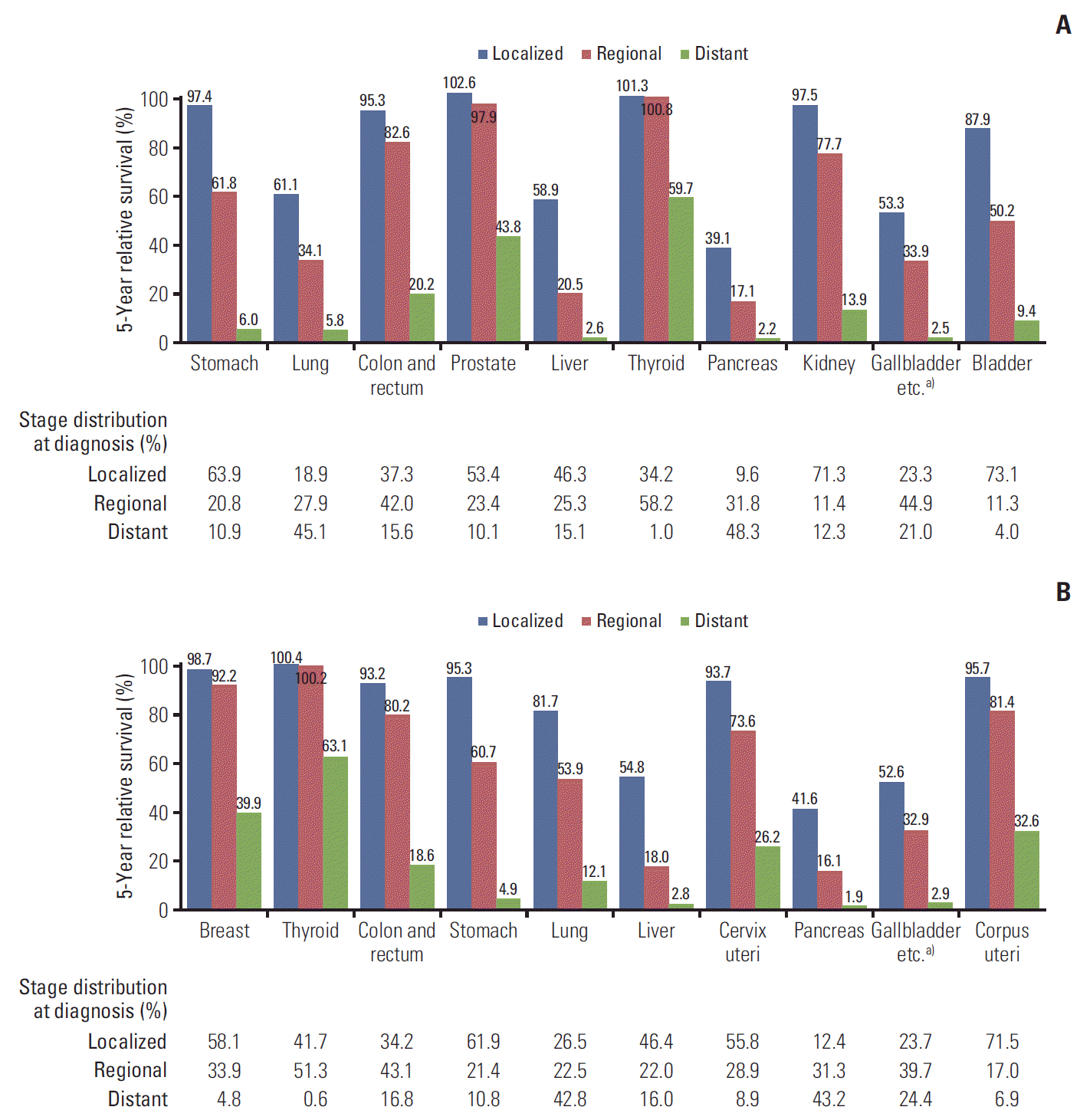 | Fig. 6.Five-year relative survival rates by stage at diagnosis and stage distribution of selected cancers by sex in Korea, 2013-2017. (A) Men. (B) Women. Staging according to the Surveillance, Epidemiology, and End Results (SEER) stage categories. For each cancer type, stage categories do not total 100% because sufficient information was not available to stage all cases. a)Includes the gallbladder and other/unspecified parts of the biliary tract. |
5. Prevalence rates
Table 8.
| Site/Type |
Crude prevalence rate per 100,000a) |
Age-standardized prevalence rate per 100,000b) |
||||
|---|---|---|---|---|---|---|
| Both sexes | Men | Women | Both sexes | Men | Women | |
| All sites | 3,645.1 | 3,205.4 | 4,083.5 | 2,126.0 | 1,952.5 | 2,384.7 |
| Lip, oral cavity, and pharynx | 49.7 | 66.5 | 32.9 | 29.5 | 41.2 | 19.2 |
| Esophagus | 20.3 | 36.4 | 4.2 | 10.7 | 21.1 | 2.0 |
| Stomach | 564.6 | 748.3 | 381.4 | 301.5 | 437.6 | 188.9 |
| Colon and rectum | 490.1 | 583.8 | 396.6 | 258.8 | 343.0 | 190.6 |
| Liverc) | 132.9 | 199.7 | 66.3 | 75.5 | 120.3 | 34.8 |
| Gallbladderd) | 43.7 | 44.9 | 42.5 | 22.1 | 25.9 | 19.1 |
| Pancreas | 23.0 | 24.1 | 21.8 | 12.8 | 14.5 | 11.4 |
| Larynx | 21.5 | 40.4 | 2.6 | 11.2 | 23.4 | 1.2 |
| Lunge) | 164.4 | 202.6 | 126.4 | 87.0 | 118.0 | 63.2 |
| Breast | 424.0 | 3.1 | 843.5 | 255.9 | 1.9 | 503.7 |
| Cervix uteri | 107.2 | - | 214.1 | 63.6 | - | 124.3 |
| Corpus uteri | 50.0 | - | 99.8 | 30.2 | - | 59.4 |
| Ovary | 41.0 | - | 81.9 | 26.9 | - | 53.5 |
| Prostate | 168.7 | 337.9 | - | 80.2 | 189.3 | - |
| Testis | 6.7 | 13.5 | - | 6.0 | 11.8 | - |
| Kidney | 83.0 | 111.9 | 54.2 | 49.1 | 69.6 | 30.7 |
| Bladder | 69.5 | 113.5 | 25.6 | 34.8 | 65.7 | 11.1 |
| Brain and CNS | 22.9 | 23.5 | 22.3 | 19.1 | 20.1 | 18.0 |
| Thyroid | 790.6 | 277.7 | 1,302.0 | 510.0 | 183.0 | 834.8 |
| Hodgkin lymphoma | 5.9 | 7.3 | 4.4 | 4.8 | 5.8 | 3.8 |
| Non-Hodgkin lymphoma | 63.5 | 72.2 | 54.7 | 43.1 | 51.7 | 35.0 |
| Multiple myeloma | 12.4 | 13.1 | 11.8 | 6.8 | 7.7 | 6.0 |
| Leukemia | 43.4 | 48.4 | 38.4 | 39.4 | 44.1 | 34.6 |
| Other and ill-defined | 246.4 | 236.8 | 256.0 | 147.2 | 156.9 | 139.4 |
a) Crude prevalence rate: number of prevalent cases divided by the corresponding person-years of observation. Prevalent cases were defined as patients who were diagnosed between January 1, 1999 and December 31, 2017, and who were alive on January 1, 2018. Multiple primary cancer cases were counted multiple times,




 PDF
PDF Citation
Citation Print
Print


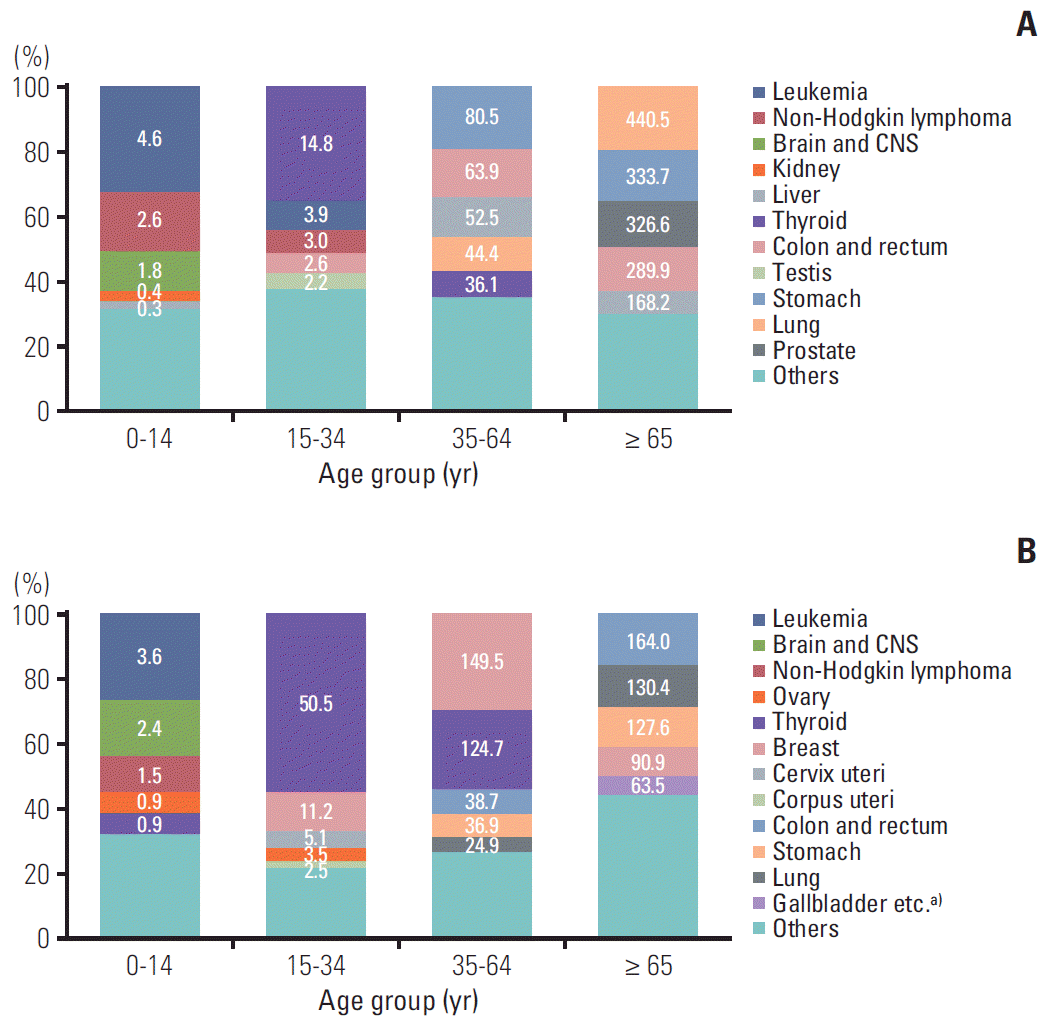
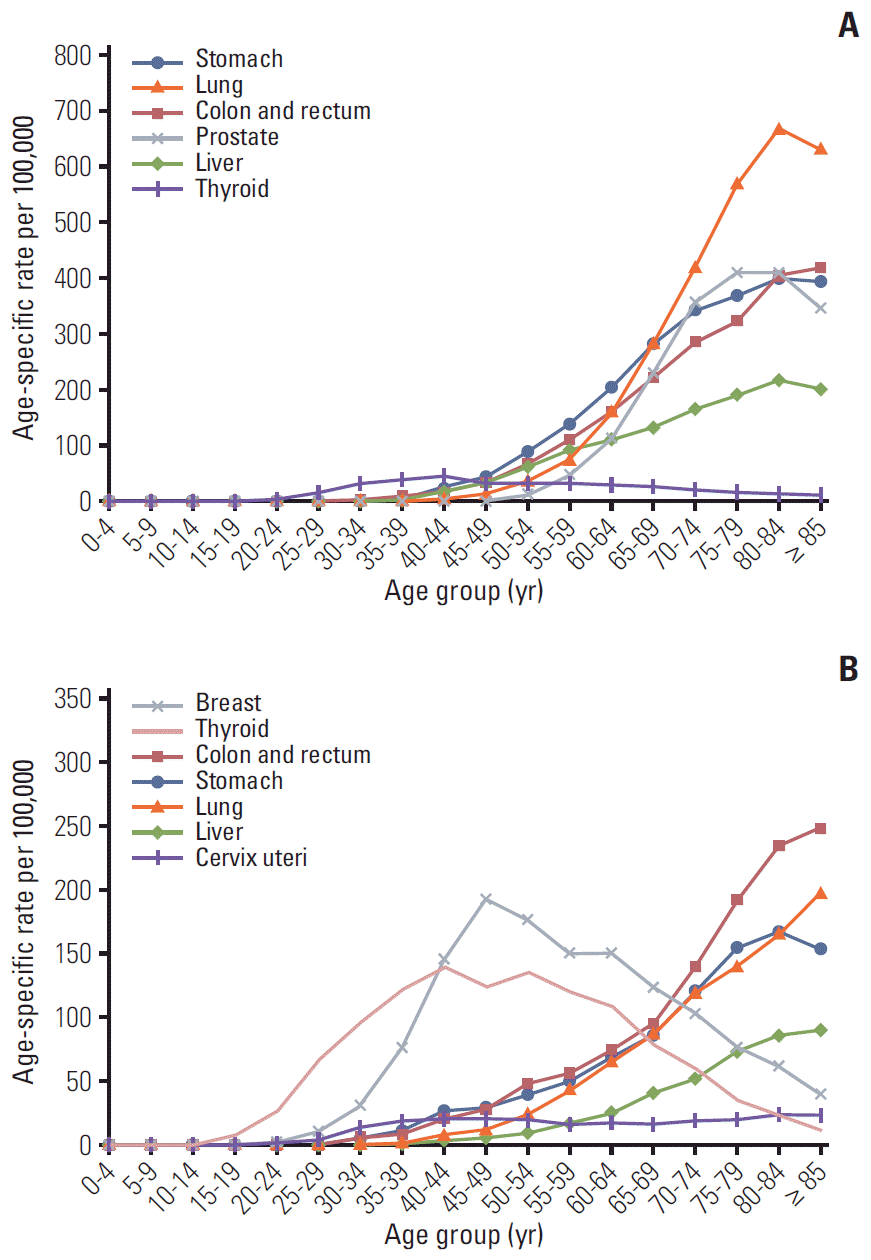
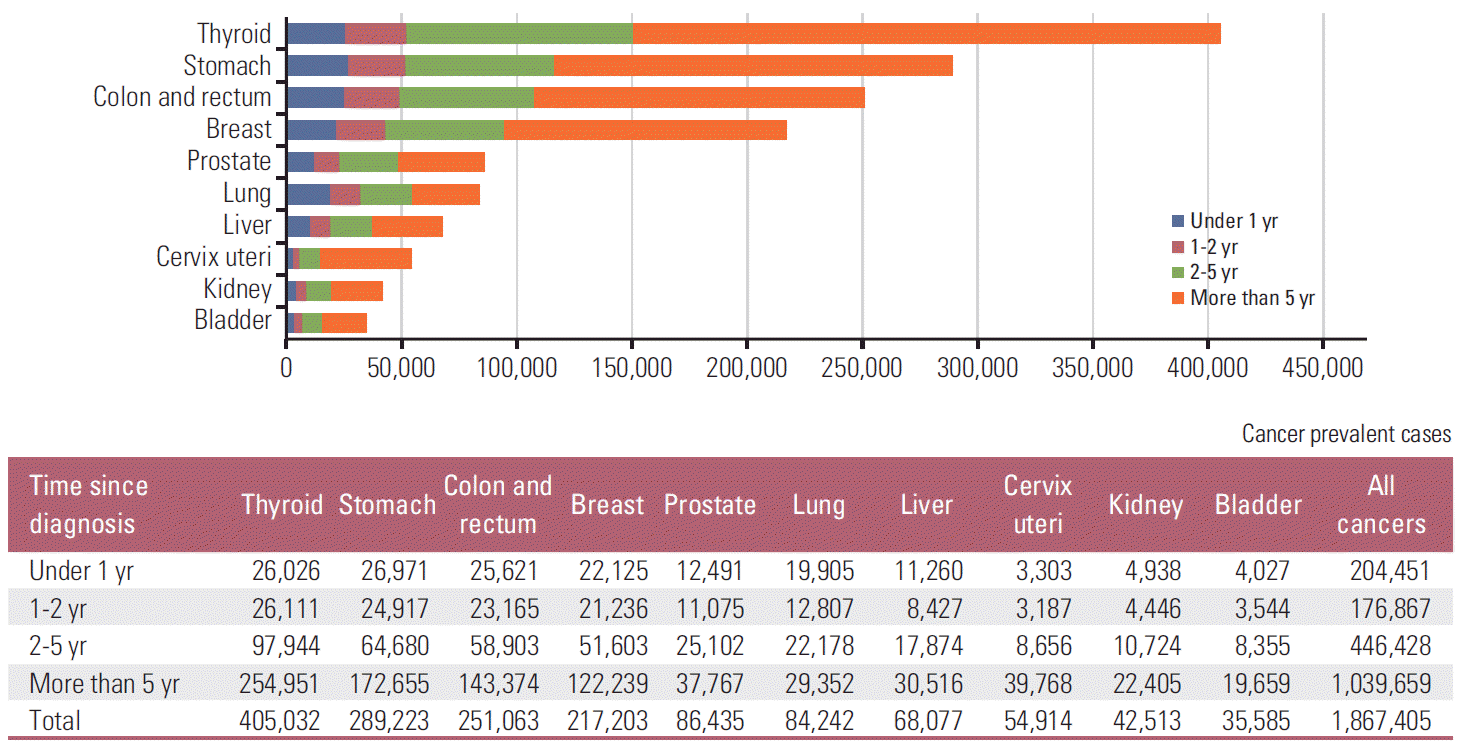
 XML Download
XML Download